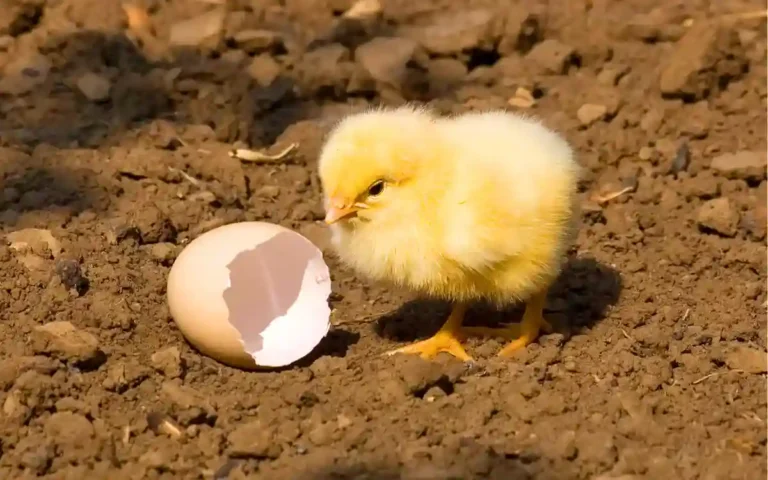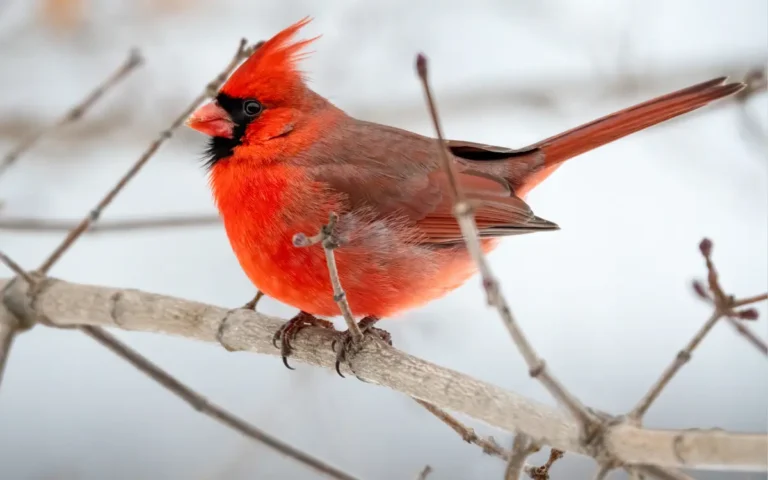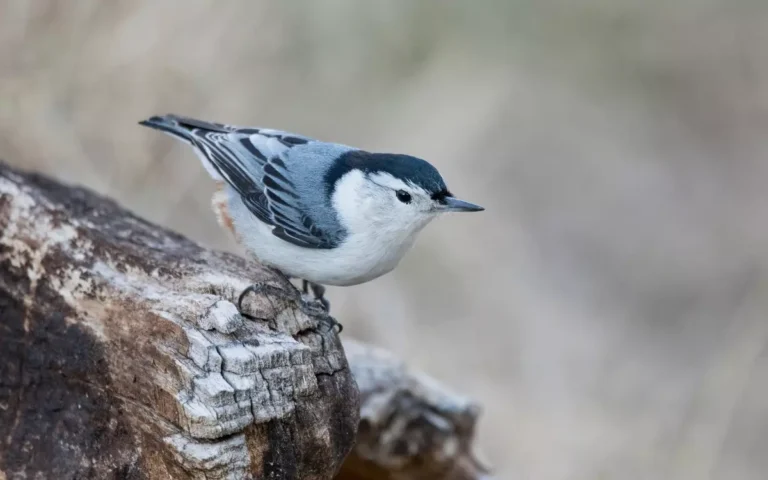Blue Jay vs Scrub Jay: Everything you need to know
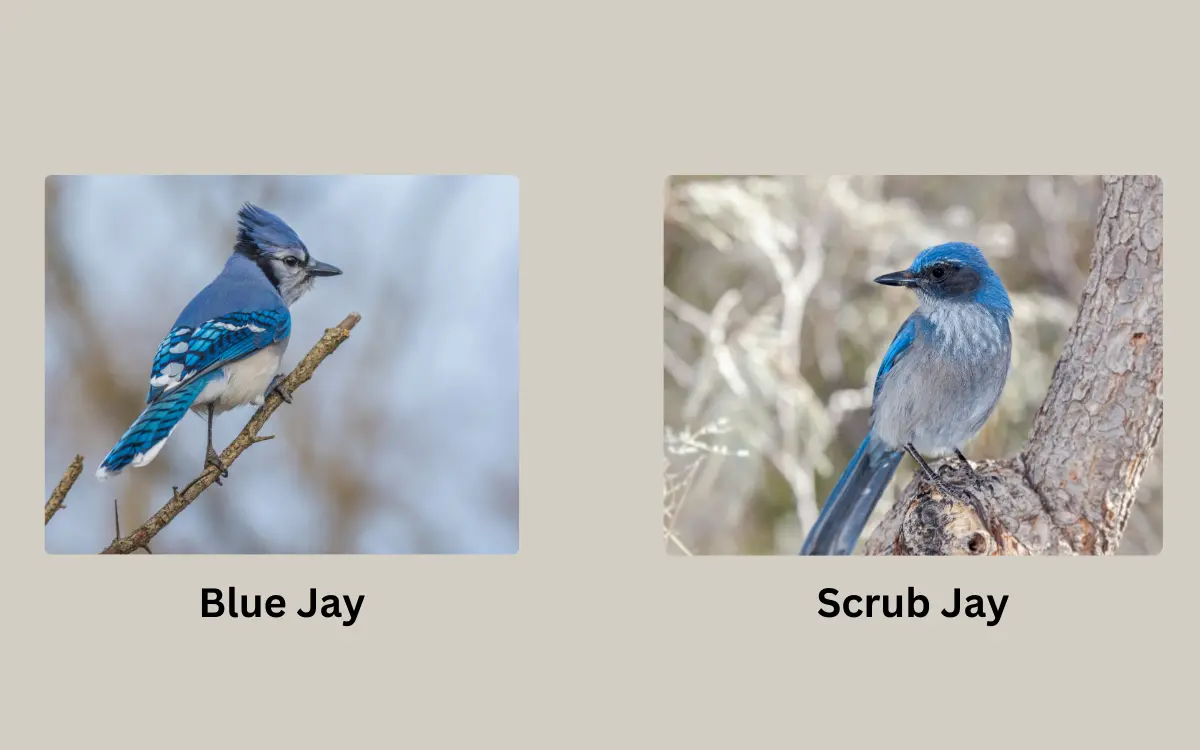
Welcome to our birdwatcher’s delight! Blue Jay vs Scrub Jay – these two vibrant birds often spark curiosity. Wondering how they differ? Let’s dive in and find out!
Blue Jay vs Scrub Jay: Everything you need to know
1.Physical Characteristics
Blue Jay
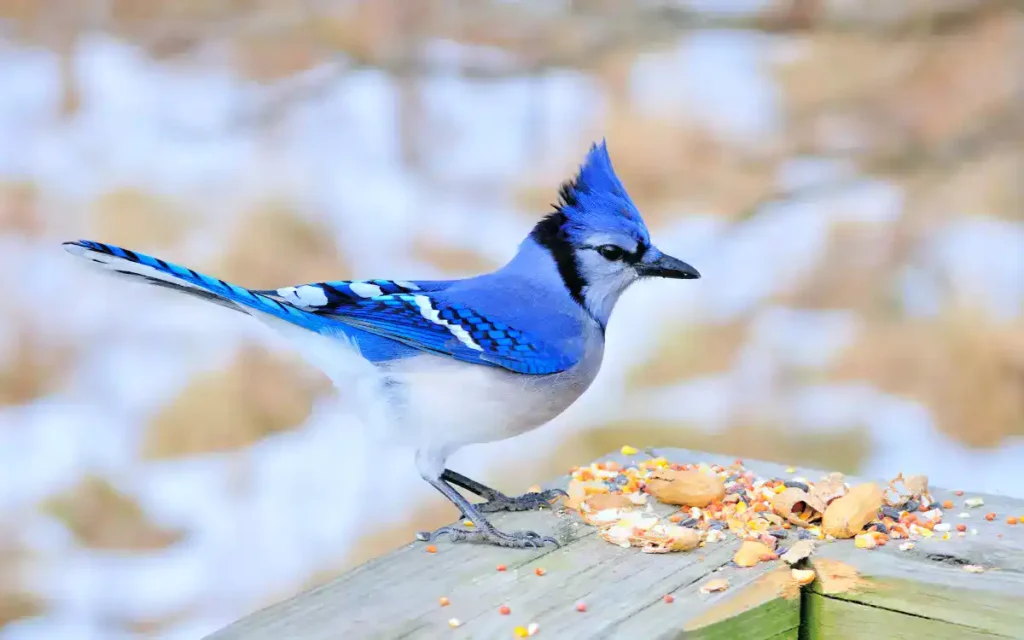
Blue jay sound
- Scientific Name: Cyanocitta cristata
- Size: About 9-12 inches in length
- Appearance: Notable bright blue plumage on its back and wings, with a white chest and underparts. It has a distinctive blue crest on its head and black markings around its bill and neck.
- Habitat: Commonly found in forests, woodlands, and suburban gardens in eastern and central North America.
The Blue Jay is a striking bird known for its vibrant blue and white coloring. One of its most prominent features is its crest, which can be raised or lowered to express its mood. Around its neck, the Blue Jay sports a unique black necklace. Its wings and tail display a beautiful pattern, being barred with black.
In terms of size, Blue Jays are relatively large for songbirds, often measuring around 10 to 12 inches in length. They are versatile in their habitat preferences, commonly found in forests, woodlands, and even in suburban and urban areas across eastern and central North America.
As for their diet, Blue Jays are not picky eaters. They enjoy a variety of foods, including insects, nuts, seeds, and grains. They are particularly fond of acorns, making them an important species for oak tree proliferation.
Scrub Jay
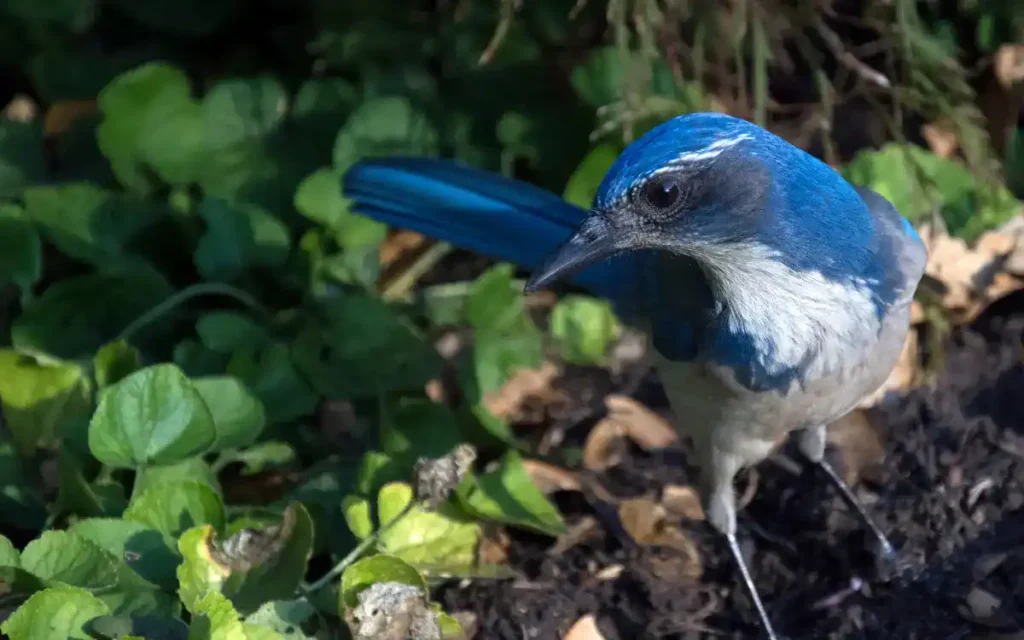
Scrub jay sound
- Scientific Name: Aphelocoma californica
- Size: Approximately 11-12 inches long
- Appearance: Lacks a crest and is mostly blue with a grayish-brown back and underparts. It has a distinctive white throat and a blue necklace-like band across the throat and chest.
- Habitat: Found in western North America, especially in areas with scrub oak and pinyon-juniper woods.
The Scrub Jay, on the other hand, exhibits some distinct differences. Unlike the Blue Jay, Scrub Jays do not have a crest. They are known for their blue and gray coloration, with variations depending on the subspecies. For instance, the Florida Scrub-Jay has a whitish forehead, which is a notable feature setting it apart from other jays.
Scrub Jays are slightly smaller than Blue Jays, usually measuring around 11 inches in length. They prefer habitats like scrub, oak woodlands, and pinyon-juniper forests. These birds are primarily found in the western United States, with the Florida Scrub-Jay being an exception as it is found in Florida.
Their diet is somewhat similar to that of the Blue Jay, with a strong preference for insects, fruits, seeds, and nuts, particularly acorns.
Comparison
When comparing the two, the most noticeable difference is the crest of the Blue Jay, which is absent in the Scrub Jay. The coloration also differs; Blue Jays have a more pronounced blue and white pattern, while Scrub Jays display more subdued shades of blue and gray. Habitat-wise, Blue Jays are more adaptable to different environments, whereas Scrub Jays have more specific habitat preferences.
Both species play crucial roles in their ecosystems, particularly in seed dispersal due to their acorn-based diets.
Read also:- Blue Jay Spiritual Meaning: Symbolism and Love Revealed
2.Behavioral Traits
Blue Jay
Blue Jays are known for their loud and aggressive behavior, especially when defending their territory. They are not shy to make their presence known with their distinctive “jay” calls. This noisiness can often alert other birds to potential dangers, like predators.
In terms of social structure, Blue Jays are quite interesting. They can be found in both small family groups or in larger flocks. These flocks are often observed during migration, a behavior that is still somewhat of a mystery to scientists.
When it comes to feeding, Blue Jays are opportunistic. They eat a wide range of foods, including seeds, nuts, and insects. They are particularly fond of acorns, often storing them for later use. This behavior helps in the spread of oak trees.
Nesting habits of Blue Jays are collaborative. Both the male and female participate in building the nest, which is usually located in the branches of a tree. The female lays and incubates the eggs, while the male provides food.
Scrub Jay
Scrub Jays, in contrast, show some different behaviors. Unlike Blue Jays, they are known for their acorn caching. This means they store acorns for future use. This behavior is crucial for the spread of oak trees in their habitat.
In their social life, Scrub Jays are typically less noisy and less aggressive than Blue Jays. They are known to form long-term pair bonds, meaning they stay with the same partner for many years, sometimes for life.
Scrub Jays’ feeding habits are similar to Blue Jays, focusing on nuts, seeds, and insects. However, their method of storing food is unique, as they hide seeds and nuts in various places for later use.
When it comes to nesting, the female Scrub Jay is primarily responsible for building the nest and incubating the eggs, while the male provides food and protection.
Comparison
Comparing the two, the most significant behavioral difference is the acorn caching habit of the Scrub Jay versus the more aggressive and social nature of the Blue Jay. The Blue Jay’s tendency to form larger flocks and their loud calls are in contrast to the Scrub Jay’s quieter and more solitary nature.
Both birds play essential roles in their ecosystems, with their feeding and nesting habits contributing significantly to the environment.
3.Habitat and Distribution
Blue Jay
The Blue Jay is widely found across eastern and central North America. Their geographical range extends from southern Canada through the eastern United States down to Florida and as far west as Texas. Blue Jays are quite adaptable birds and can thrive in various environments. They are commonly seen in deciduous and coniferous forests, but they are also comfortable in urban and suburban areas. This adaptability to different habitats, including human-dominated landscapes, is a key reason for their widespread presence.
Scrub Jay
Scrub Jays, in contrast, have a more localized distribution. They are primarily found in the western United States, with different subspecies occupying specific regions. For example, the Florida Scrub-Jay is endemic to the Florida peninsula, where it inhabits oak scrub and scrubby flatwoods. The California Scrub-Jay is found along the Pacific Coast, and the Woodhouse’s Scrub-Jay lives in the interior West. These birds are specially adapted to their particular habitats, which often include dry, open areas such as chaparral, oak woodlands, and pinyon-juniper forests. Their preference for scrubby, open areas is a defining feature of their habitat choices.
Comparison
In comparing the two, the Blue Jay’s wide range and adaptability stand out against the Scrub Jay’s more localized and specialized habitat preferences. While Blue Jays can be found in a variety of settings, including near human habitation, Scrub Jays are more tied to specific habitats that meet their unique needs, such as oak scrublands or pinyon-juniper woodlands.
4.Conservation Status
Blue Jay
The Blue Jay, as a species, is currently not facing significant conservation threats. It is categorized as Least Concern by the International Union for Conservation of Nature (IUCN). This status is due in part to their wide distribution and adaptability to various habitats, including areas influenced by humans. However, like all wildlife, they can be affected by habitat loss and environmental changes, particularly in urban settings.
Florida Scrub-Jay
The situation is more serious for the Florida Scrub-Jay, which is listed as Endangered. This bird is unique because it’s found only in Florida, making its population more vulnerable. The main threat to the Florida Scrub-Jay is habitat loss, primarily due to urban development and changes in land use. Their natural habitat, the oak scrub, has been significantly reduced, which has had a direct impact on their numbers. Conservation efforts are underway to protect and restore these habitats to help the Florida Scrub-Jay population recover.
Impact of Habitat Loss and Environmental Changes
Both species are affected by changes in their environment, though in different ways. The Blue Jay, with its adaptability, may not currently be at high risk, but ongoing environmental changes and loss of forest areas could pose challenges in the future. For the Florida Scrub-Jay, the situation is more immediate, with habitat loss directly impacting their survival. Conservation efforts for these birds include protecting natural habitats, restoration projects, and public education about the importance of these species and their environments.
5.Interaction with Humans
Blue Jay
Blue Jays are known for their bold interaction with humans, especially in suburban areas. They are often seen visiting backyard bird feeders, where they are not shy about making their presence known. Blue Jays have a reputation for being intelligent and curious, often figuring out how to access food in tricky bird feeders.
In some neighborhoods, Blue Jays are known for their loud calls, which can be both amusing and, at times, a bit disruptive. They have also been observed mimicking the calls of hawks, which can be confusing or startling to people not familiar with this behavior.
Scrub Jay
Scrub Jays, particularly the Western Scrub-Jay, are also known to visit backyard feeders, but they tend to be a bit more reserved compared to Blue Jays. They are especially fond of peanuts and sunflower seeds. Some people have even trained Scrub Jays to take nuts from their hands!
In areas where their natural habitat overlaps with human development, Scrub Jays have adapted to living close to people. However, they are not as commonly seen in urban settings as Blue Jays.
Anecdotes and Observations
There are numerous anecdotes of Blue Jays playfully interacting with human objects, such as picking up shiny items or playfully engaging with objects in gardens. Similarly, Scrub Jays in backyard settings might exhibit clever behaviors, such as hiding food for later retrieval.
Both species show a remarkable ability to adapt to the presence of humans, with Blue Jays being more dominant and noticeable and Scrub Jays showing a quieter but still clever interaction style.
6.Misconceptions and Common Mistakes
Similar Physical Traits
A common mistake people make is confusing the Blue Jay and the Scrub Jay due to their similar blue coloring. However, there are distinct features that set them apart.
Blue Jay Identification
To correctly identify a Blue Jay, look for these key traits:
- A prominent crest on their head that they can raise or lower.
- Their coloring is primarily bright blue on the back and white underneath.
- They have a black necklace-like pattern across the throat and around the neck.
- Their wings and tail feature distinct black bars and white spots.
Scrub Jay Identification
For a Scrub Jay, these features are notable:
- They do not have a crest on their head.
- Their coloring is more subdued, with shades of blue on the back and a lighter belly.
- Florida Scrub-Jays have a whitish forehead, which is a unique feature among jays.
- They lack the black necklace pattern seen in Blue Jays.
Tips for Identification
- Pay attention to the head: The presence or absence of a crest is a big clue.
- Look at the coloring and patterns: Blue Jays are brighter with more pronounced patterns.
- Consider the location: Knowing the typical range of each bird can help in identification. Blue Jays are more common in eastern and central North America, while Scrub Jays are found in the western parts.
Cultural and Ecological Significance
Ecosystem Balance
Both Blue Jays and Scrub Jays play significant roles in their ecosystems. One of their key contributions is in seed dispersion. These birds often collect seeds, like acorns, and either eat them or hide them in various places. Many of these hidden seeds are not retrieved, which allows them to grow into new plants and trees, helping in forest regeneration and maintaining biodiversity.
Blue Jays
From an ecological perspective, Blue Jays are known for their role in spreading oak trees through their acorn-feeding habits. In terms of cultural significance, they are often viewed as symbols of intelligence and curiosity due to their clever behaviors. In some cultures, they are also seen as messengers bringing news or warnings.
Scrub Jays
Scrub Jays, particularly the Florida Scrub-Jay, play a crucial role in maintaining the oak scrub ecosystems. They are essential for the germination of new oak trees due to their acorn caching behavior. Culturally, Scrub Jays may not be as prominent as Blue Jays, but they are often admired for their resourcefulness and adaptation skills.
Faqs
Are blue jays aggressive?
Yes, Blue Jays can be aggressive, especially in defending their territory or resources.
Is a blue jay a rare bird?
No, Blue Jays are not rare; they are quite common in their natural range across eastern and central North America.
Are blue jays rare?
No, Blue Jays are not considered rare but are widespread and common in their habitat.
Are blue jays friendly to humans?
Blue Jays are not typically known for being particularly friendly to humans, but they can coexist peacefully in human-inhabited areas.
Are jays intelligent?
Yes, jays, including Blue Jays, are considered intelligent birds, known for their problem-solving skills and complex social behaviors.
Conclusion
While Blue Jays and Scrub Jays share similarities, their distinct physical and behavioral traits set them apart, each playing a unique role in their ecosystems. For more insights into bird comparisons, explore articles about “Blue Jay vs Cardinal” to further your understanding of these fascinating creatures.


